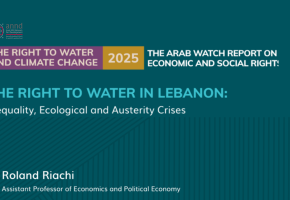
Social Dimensions of Climate Change in Egypt - Abdelmawla Ismail
Climate change is one of the most influential phenomena impacting the biosphere and the human environment at all levels. Its economic and social repercussions continue to spread under the threat of extinction-level disasters that might befall the planet.
Focusing on these repercussions, environmental and climate scientists are sounding the alarm bell to alert the international community to the dangers of climate change. Consequently, nations and peoples began to take the initiative to adopt the necessary measures to limit its repercussions. They began with the Earth Summit 1992 and its consequent summits, agreements, treaties, protocols, and framework paths. The trajectory led to the Conference of Partners (COP) climate summits starting in 1995 and reaching the Baku COP29 and anticipated future summits.
In this context, we address some dimensions usually absent from these climate summit processes. They are related to the social dimensions of climate change as a phenomenon. We shall use the Egyptian case as an example. The country has made great strides in addressing climate change, which is evident in the emergence of the National Strategy for Climate Change in Egypt 2035, which intersected with other strategies, including the National Water Strategy 2050 and another one specific to green hydrogen.
However, these strategies combined contain many essential features, such as the commodification of climate and natural resources to integrate them into exchange markets as commodities that can be bought and sold, as well as further depletion and displacement of these resources to the countries of the North.
These strategies also mimic international financial institutions (IFIs) and the prevalent discourse in the COP process. This discourse focuses on integrating the countries of the world, especially developing ones, to contribute to strategies related to mitigating greenhouse gas emissions based on equal responsibility instead of focusing on strategies related to how to work to confront the losses and damages resulting from the warming process and the measures that must be taken. Egypt, in particular, is exposed to the erosion of its northern coasts and agricultural areas, reaching 5.2 million feddans (a feddan equals 4200 square meters) in the Delta region alone. As a mere example, the situation risks further exposure related to the Egyptian food gap, which exceeds 51.8% in wheat and 77.2% in beans.
Instead of confronting these risks that threaten the food security situation in Egypt and working to develop climate strategies that consider these dimensions, we find, on the contrary, strategies that exacerbate this situation related to people's lives and livelihoods.
In this context, the National Climate Strategy called for restructuring Egyptian crops by reducing the area of water-intensive crops such as rice, mainly grown in the Delta region, and sugar cane, which is concentrated in the Upper Egypt region. The restructuring was repeated in statements by IFIs, like the World Bank, which concluded a loan with the Egyptian government to regulate water use in several Delta governorates in Egypt, namely Sharqia, Menoufia, and Gharbia, to work on converting methods related to flood irrigation to drip irrigation.
As a result of these strategies, Egypt reduced its area planted with rice from 1.5 million feddans in 2012 to 1.1 million in 2023. This reduction will directly impact the nutritional status of the 45 million people in the Delta region, considering that rice is the primary food, much like wheat and corn, in the rest of the country.
Furthermore, the matter extends to protecting the lands of the Delta, around 5.2 million feddans, from being eroded by the waters of the Mediterranean Sea. Throughout its history, Egypt has cultivated rice in the Delta region and used flood irrigation techniques in its low-lying lands to create a natural water barrier that prevents the infiltration of seawater salinity into agricultural lands.
In contrast, the framework of the mitigation strategies adopted by the National Climate Strategy in Egypt intersects with another strategy related to producing 20 million tons of green hydrogen for export to European countries by 2035. Thus, more renewable energy would be drained instead of used to cover the gap in access to electricity, which is witnessing continuous increases in its prices. In addition, it is expected to deplete more freshwater resources from at least 0.6 billion cubic meters of water.
The Egyptian case highlights the contradictions in addressing climate change. While its strategy aims to provide the water resources necessary for food and considers the social dimension, it calls for overusing those resources to invest in international markets and produce green hydrogen.
In the same context, the National Climate Change Strategy prioritizes spending on mitigation. The mitigation budget until 2035 amounts to $211 million, while the adaptation budget amounts to $113 million. These funds are mainly in the form of loans from IFIs.
Nonetheless, the National Climate Change Strategy drafters should have demanded the implementation of the principle of climate justice, based in part on obligating the countries of the North and the most polluting countries to bear their historical responsibility for climate debt. Egypt’s carbon dioxide emissions amounted to 4.9 million tons from 1990 to 2020, compared to 162.7 million tons for the United States and 100 million tons for the European Union in the same period. Germany alone had a share of 25 million tons, and China’s total CO2 emissions amounted to 191.8 million tons.
In return, Egypt and the countries of the South must demand that the most polluting countries pay their share of the climate debt owed to the Loss and Damage Fund or establish a climate debt fund in which each country bears what it must pay in money to the climate creditor countries according to the debt and credit balance of each country separately. This debt must be calculated from the mid-nineteenth century until today. At the upcoming Baku Summit, we must insist that the funding allocated to the adaptation strategy be higher than that assigned to the mitigation strategy, averting the expected risks for the countries most vulnerable to climate change, including Egypt.
Abdelmawla Ismail
Environment and Development Researcher
Recent publications

Neoliberalism and Feminist Discourse: Between Assimilation and Resistance in the Arab Context

The Right to Water in Lebanon: Inequality, Ecological and Austerity Crises - Roland Riachi
Related publications

An Alternative progressive cycle and a revitalized multilateral system - Roberto Bissio
